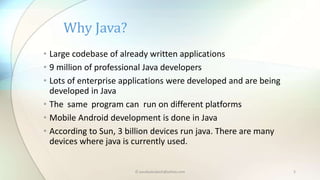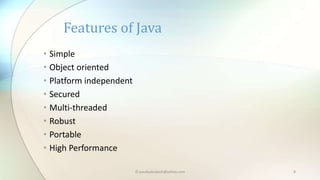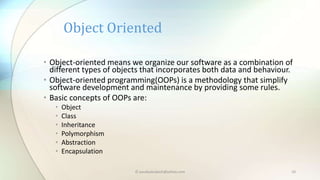Ad
Java fundamentals
- 1. Instructor: @Subash @Paudyal Pokhara & Tribhuvan University Kathmandu, Nepal Training on Java Programming
- 2. • Java Introduction • Java History • Why Learn Java • Java Version • Java IDE • Java Features • Java Program Structure • What happens at Compile and Runtime ? • Distinction between JVM, JRE and JDK Session 1: Fundamentals © [email protected] 2
- 3. • Java is a programming language and a platform. • Java is a high level, robust, secured and object-oriented programming language. Introduction (What java) © [email protected] 3
- 4. • James Gosling, Mike Sheridan, and Patrick Naughton initiated the Java language project in June 1991. • Firstly, it was called "Greentalk" by James Gosling and file extension was .gt. • After that, it was called Oak and was developed as a part of the Green project. • Why Oak? Oak is a symbol of strength and chosen as a national tree of many countries like U.S.A., France, Germany, Romania etc. (presumably because he liked the look of an oak tree that was right outside his window at Sun). • In 1995, Oak was renamed as "Java" because it was already a trademark by Oak Technologies. • Why java? The team gathered to choose a new name. According to James Gosling "Java was one of the top choices along with Silk". Since java was so unique, most of the team members preferred java. • Java is an island of Indonesia where first coffee was produced (called java coffee). • Originally developed by James Gosling at Sun Microsystems (which is now a subsidiary of Oracle Corporation) and released in 1995. History (How Java) © [email protected] 4
- 5. Why Java? • Large codebase of already written applications • 9 million of professional Java developers • Lots of enterprise applications were developed and are being developed in Java • The same program can run on different platforms • Mobile Android development is done in Java • According to Sun, 3 billion devices run java. There are many devices where java is currently used. © [email protected] 5
- 6. • Some of the devices using java are as follows: • Desktop Applications such as acrobat reader, media player, antivirus etc. • Web Applications such as irctc.co.in, javatpoint.com etc. • Enterprise Applications such as banking applications. • Mobile • Embedded System • Smart Card • Robotics • Games etc. Devices using Java © [email protected] 6
- 7. • There are mainly 4 type of applications that can be created using java programming: • Standalone Application: (J2SE) – Standard Edition It is also known as desktop application or window-based application. An application that we need to install on every machine such as media player, antivirus etc. AWT and Swing are used in java for creating standalone applications. • Web Application: An application that runs on the server side and creates dynamic page, is called web application. Currently, servlet, jsp, struts, jsf etc. technologies are used for creating web applications in java. • Enterprise Application: (J2EE) – Enterprise Edition An application that is distributed in nature, such as banking applications etc. It has the advantage of high level security, load balancing and clustering. In java, EJB is used for creating enterprise applications. • Mobile Application: (J2ME) – Micro Edition An application that is created for mobile devices. Currently Android and Java ME are used for creating mobile applications. Types of Java Applications © [email protected] 7
- 8. • Simple • Object oriented • Platform independent • Secured • Multi-threaded • Robust • Portable • High Performance Features of Java © [email protected] 8
- 9. • syntax is based on C++ (so easier for programmers to learn it after C++). • removed many confusing and/or rarely-used features e.g., explicit pointers, operator overloading etc. • No need to remove unreferenced objects because there is Automatic Garbage Collection in java. Simple © [email protected] 9
- 10. • Object-oriented means we organize our software as a combination of different types of objects that incorporates both data and behaviour. • Object-oriented programming(OOPs) is a methodology that simplify software development and maintenance by providing some rules. • Basic concepts of OOPs are: • Object • Class • Inheritance • Polymorphism • Abstraction • Encapsulation Object Oriented © [email protected] 10
- 11. • A platform is the hardware or software environment in which a program runs. • There are two types of platforms software-based and hardware-based. • Java provides software-based platform. The Java platform differs from most other platforms in the sense that it's a software-based platform that runs on top of other hardware-based platforms. • It has two components: • Runtime Environment • API(Application Programming Interface) • java is platform independent Java code can be run on multiple platforms e.g.Windows,Linux,Sun Solaris,Mac/OS etc. • Java code is compiled by the compiler and converted into bytecode.This bytecode is a platform independent code because it can be run on multiple platforms i.e. Write Once and Run Anywhere(WORA). Platform Independent © [email protected] 11
- 13. • Java is secured because: • No explicit pointer • Programs run inside virtual machine sandbox. • Security provided by Java Language • Classloader • adds security by separating the package for the classes of the local file system from those that are imported from network sources. • Bytecode Verifier • checks the code fragments for illegal code that can violate access right to objects. • Security Manager • determines what resources a class can access such as reading and writing to the local disk. Secure © [email protected] 13
- 14. • A thread is like a separate program, executing concurrently. We can write Java programs that deal with many tasks at once by defining multiple threads. The main advantage of multi-threading is that it shares the same memory. Threads are important for multi-media, Web applications etc. • Robust simply means strong. Java uses strong memory management. There are lack of pointers that avoids security problem. There is automatic garbage collection in java. There is exception handling and type checking mechanism in java. All these points makes java robust. • We may carry the java bytecode to any platform. • Java is faster than traditional interpretation since byte code is "close" to native code still somewhat slower than a compiled language (e.g., C++) Multi-Tasking, Robust, Portable, high performance © [email protected] 14
- 15. Run First Program • Three steps to run the Java program Write the program and save it in a file with the name that ends with .java, for example HelloWorld.java Compile the program using javac compiler which creates HelloWorld.class file, for example javac HelloWorld.java Run your program: java HelloWorld class HelloWorld { public static void main(String[] args) { System.out.println (“Hello, world!"); } } © [email protected] 15
- 16. • class keyword is used to declare a class in java. • public keyword is an access modifier which represents visibility, it means it is visible to all. • (if its not public JVM classes might not able to access it) • static is a keyword, if we declare any method as static, it is known as static method. The core advantage of static method is that there is no need to create object to invoke the static method. The main method is executed by the JVM, so it doesn't require to create object to invoke the main method. So it saves memory. • (While JVM tries to execute Java program it doesn't know how to create instance of main class as there is no standard constructor is defined for main class) • void is the return type of the method, it means it doesn't return any value. • (because it doesn't return any thing to caller which is JVM) • main represents startup of the program. • String[] args is used for command line argument. We will learn it later. • System.out.println() is used print statement. We will learn about the internal working of System.out.println statement later. Understanding Keywords © [email protected] 16
- 17. • At compile time, java file is compiled by Java Compiler and converts the java code into bytecode. • It does not interact with OS What happens at compile time? © [email protected] 17
- 18. What happens at runtime? © [email protected] 18
- 19. • JVM (Java Virtual Machine) is an abstract machine. It is a specification that provides runtime environment in which java bytecode can be executed. • JVMs are available for many hardware and software platforms. JVM, JRE and JDK are platform dependent because configuration of each OS differs. But, Java is platform independent. • The JVM performs following main tasks: • Loads code • Verifies code • Executes code • Provides runtime environment Difference between JVM, JRE and JDK © [email protected] 19
- 20. • JRE is an acronym for Java Runtime Environment.It is used to provide runtime environment.It is the implementation of JVM. • It physically exists. It contains set of libraries + other files that JVM uses at runtime. • Implementation of JVMs are also actively released by other companies besides Sun Micro Systems. JRE © [email protected] 20
- 21. • JDK is an acronym for Java Development Kit. • It physically exists.It contains JRE + development tools. JDK © [email protected] 21
- 22. Java IDE • Integrated Development Environment (IDE) • Makes your work more productive • Includes text editor, compiler, debugger, context sensitive, help, works with different Java SDKs • Most widely used IDEs: • Netbeans (Oracle) • Eclipse (Open) • Intellijidea (Jetbrains) © [email protected] 22
- 23. • Queries? End of Java Introduction © [email protected] 23















![Run First Program
• Three steps to run the Java
program
Write the program and save it in a file
with the name that ends with .java,
for example
HelloWorld.java
Compile the program using javac
compiler which creates
HelloWorld.class file, for example
javac HelloWorld.java
Run your program:
java HelloWorld
class HelloWorld {
public static void main(String[] args)
{
System.out.println (“Hello,
world!");
}
}
© paudyalsubash@yahoo.com 15](https://image.slidesharecdn.com/javafundamentals-150111235906-conversion-gate01/85/Java-fundamentals-15-320.jpg)
![• class keyword is used to declare a class in java.
• public keyword is an access modifier which represents visibility, it means it is visible to all.
• (if its not public JVM classes might not able to access it)
• static is a keyword, if we declare any method as static, it is known as static method. The
core advantage of static method is that there is no need to create object to invoke the
static method. The main method is executed by the JVM, so it doesn't require to create
object to invoke the main method. So it saves memory.
• (While JVM tries to execute Java program it doesn't know how to create instance of main
class as there is no standard constructor is defined for main class)
• void is the return type of the method, it means it doesn't return any value.
• (because it doesn't return any thing to caller which is JVM)
• main represents startup of the program.
• String[] args is used for command line argument. We will learn it later.
• System.out.println() is used print statement. We will learn about the internal working of
System.out.println statement later.
Understanding Keywords
© paudyalsubash@yahoo.com 16](https://image.slidesharecdn.com/javafundamentals-150111235906-conversion-gate01/85/Java-fundamentals-16-320.jpg)























































![Get & Download Wondershare Filmora Crack Latest [2025]](https://cdn.slidesharecdn.com/ss_thumbnails/revolutionizingresidentialwi-fi-250422112639-60fb726f-250429170801-59e1b240-thumbnail.jpg?width=560&fit=bounds)


















